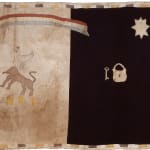 Asafo militia’s company flag, frankaa
Asafo militia’s company flag, frankaa
 Asafo militia’s company flag, frankaa
Asafo militia’s company flag, frankaa
 Asafo militia’s company flag, frankaa
Asafo militia’s company flag, frankaa
Anonymous Fante artist (Ghana)
110 12/50 x 155 51/100 in
Further images
While most flags of the Asafo companies are small enough to be presented by a flag bearer (Frankaatunyi or Frankaakitsanyi) during a festival with a spectacular dance performance, only very few flags are of this particular size are known. It would be paraded by several men together, or presented on the company’s shrine (known as Aban or Posuban). Almost four meters long, this exceptional flag has a particularly large image field that the artist filled out most sparingly, increasing the visual power of its iconography. At the left, white half of the image, one can find the company’s number and two important Akan symbols: the lion and the rooster. Above is a schematic depiction of a posuban shrine from which a rainbow emerges. The arist placed this motif to the extreme left of the image field, where it crosses the edge of the rectangular flag panel – a most unique feature, indicative for the age and importance of this exceptional flag. The rainbow extends into the dark half of the image field, connecting the two sides of the flag. In the center of this black part of the flag one can view an important Akan symbol of power: a lock and key. The message it would send is: "We are the lock and key of the state" - that is, we control the state, the lock and key being metaphors for power and control. The white, eight-pointed star (Nsoromma) adds a religious dimension to this claim to power, because the glow of the star is considered a reflection of God. The absence of the typical Union Jack in the upper left corner points to a late 19th century date for this powerful work of art. The iconographic program of this flag is both precise and comprehensive. The right side encompasses the leadership claims of its owners. The rainbow, emerging from the posuban shrine, emphasized the deadly menace posed by the company, while the lion symbolized the courage of its members. The rooster refered to the inner group solidarity and the care provided by its leader. Such a flag certainly has a very specific function due to its outstanding size and the complexity of its pictorial content. In all likelihood it graced the company shrine on important occasions.
Provenance
Collection Alain Dufour, Paris
Collection Han & Nina Simonis, Düsseldorf
Exhibitions
“Asafo. Fahnen aus Ghana”
Saarland Museum, Saarbrücken, 19 February – 17 April 1995
Afrika Museum, Berg en Dal, 1 May – 1 November 1995
Literature
Publications
Güse, Ernst-Gerhard, “Asafo. Fahnen aus Ghana”, Munich, Prestel, 1995, no. 1
let's keep in touch
Join our community & never miss out on a DUENDE moment from now on
* denotes required fields
We will process the personal data you have supplied to communicate with you in accordance with our Privacy Policy. You can unsubscribe or change your preferences at any time by clicking the link in our emails.


